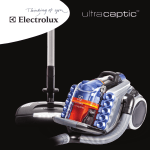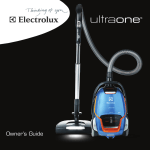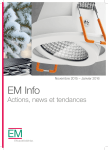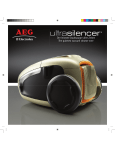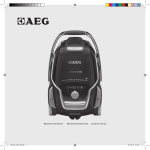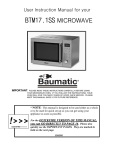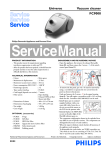Download Electrolux Elara Service manual
Transcript
SERVICE MANUAL VACUUM CLEANER © E.H.P. Floor Care Number of publication 599 71 19-22 “Elara” electronic vacuum cleaner EN Factory: Edition: 2009-02 EN Publication number 599 71 19-22 Rev. 01 02/2009 PR - 1/42 TABLE OF CONTENTS 1 2 3 4 5 6 7 8 General description .................................................................................................................................... 3 1.1 Exploded view....................................................................................................................................... 4 ACCESSIBILITY......................................................................................................................................... 6 Levels of Electronic Control...................................................................................................................... 28 3.1 Display Layout for models without remote controlled HBTN:............................................................. 28 3.1.1 Basic software functionality........................................................................................................ 28 3.1.2 Motor power regulation and LED-functionality........................................................................... 28 3.2 Display Layout for models with RF controlled HBTN: ........................................................................ 29 3.2.1 Basic software functionality........................................................................................................ 29 3.2.2 Motor power regulation and LED-functionality........................................................................... 29 3.3 Display Layout for models with Aeropro active system: ..................................................................... 31 3.3.1 Basic Software functionality ....................................................................................................... 31 3.3.2 Motor power regulation and LED-functionality........................................................................... 31 3.3.3 Brush motor functionality ........................................................................................................... 31 3.4 Nozzle power supply interface............................................................................................................ 32 3.5 Brush nozzle PCB 230V/110V active remote..................................................................................... 32 3.6 Standby indication (for both RF and active versions)......................................................................... 32 3.6.1 Reprogramming RF remote controller ....................................................................................... 32 3.6.2 Isometric view of all PCB-versions ............................................................................................ 33 3.7 Auto function, pressure sensor PCB (position 014D)......................................................................... 34 3.7.1 Functional description ................................................................................................................ 34 PCB Power Module (position 014A)......................................................................................................... 35 4.1 Introduction ......................................................................................................................................... 35 4.2 Connection for control unit.................................................................................................................. 35 4.3 Low Current Power Module ................................................................................................................ 36 4.3.1 Power supply design low current power module ....................................................................... 36 4.3.2 Electrical specification................................................................................................................ 36 4.4 High Current Power Module ............................................................................................................... 36 4.4.1 Electrical specification switched power supply .......................................................................... 36 RF transmitter........................................................................................................................................... 37 5.1 Introduction ......................................................................................................................................... 37 5.2 Design................................................................................................................................................. 37 5.2.1 Mechanical design, PCB shape................................................................................................. 37 5.3 LED indication..................................................................................................................................... 37 5.4 Changing the battery .......................................................................................................................... 37 Aeropro PCB 230V/110V motor ............................................................................................................... 38 6.1 Introduction ......................................................................................................................................... 38 6.2 PCB variants....................................................................................................................................... 38 6.3 Electrical overview .............................................................................................................................. 38 6.3.1 Functional description ................................................................................................................ 39 6.4 Description Remote control signal and handling ................................................................................ 39 6.5 Motor output........................................................................................................................................ 39 INDICATION & DIAGNOSTICS ............................................................................................................... 39 7.1 Filter and S-bag indicators.................................................................................................................. 39 7.1.1 Activation.................................................................................................................................... 39 7.1.2 Deactivation ............................................................................................................................... 40 7.2 Error handling ..................................................................................................................................... 40 7.2.1 General startup error.................................................................................................................. 40 7.2.2 Auto board error......................................................................................................................... 40 7.2.3 Aeropro PCB error handling....................................................................................................... 40 TROUBLE SHOOTING ............................................................................................................................ 41 EN Publication number 599 71 19-22 Rev. 01 02/2009 PR - 2/42 1 General description 1 2 3 4 5 6 7 8 9 10 11 12 13 14 15 16 17 18 19 20 21 22 23 24 25 26 Display Hepa filter cover Hepa filter Parking slot Power cord Motor filter Motor filter holder S-bag® Dust compartment cover Button for Aeropro 3in1, dust bag compartment Aeropro 3in1 compartment Aeropro 3in1 nozzle Aeropro hose Handle Aeropro telescopic tube Parking clip Display for models with manual control Aeropro classic handle Aeropro ergo handle Aeropro nozzle Display for models with remote control Aeropro remote control handle Aeropro remote control handle for motorized nozzle Aeropro motorized nozzle Aeropro turbo nozzle* Aeropro parketto nozzle* * Accessories may vary from model to model. EN Publication number 599 71 19-22 Rev. 01 02/2009 PR - 3/42 1.1 Exploded view EN Publication number 599 71 19-22 Rev. 01 02/2009 PR - 4/42 Pos Description Pos Description Pos Description 1 BASE 23 HOSE CONNECTION INNER 46 CLIP PARKING 2 MOTOR HOUSING 24 BUTTON FRONT COVER 47 ABSORBER FILTER LID 3 FRONT COVER 25 CORDWINDER LEVER 48 FRAME HOSE CONNECTION 4 BUTTON FRONT LID 26 DISPLAY BASE 49 SIDE FRAME LEFT 5 FRONT LID 27 FRONT WHEEL ROLL COMPLETE SOFT 50 PCB CONTROL UNIT 6 REAR COVER 28 FRONT WHEEL HOLDER 51 POWER SUPPLY UNIT AEROPRO 7 MOTOR COVER 29 SUSPENSION BLOCK DOMEL 52 SHAFT FRONT WHEEL ROLL 8 FILTER LID 30 FILTER HOLDER DISASTER FILTER 53 SHAFT FRONT WHEEL HOLDER 9 SUSPENSION RING 31 BEARING REAR WHEEL 54 CORDWINDER 10 DISPLAY WINDOW 32 SHAFT REAR WHEEL 56 FILTER HEPA 11 PEDAL CW 33 LEVER ON-OFF 57 POWER MODULE PCB 12 PEDAL ON/OFF 34 BUMPER RIGHT HANDLE 59 MOTOR FAN UNIT 13 BUTTON MIN/MAX 35 SEALING HEPA FILTER 63 MULTITOOL 14 REAR WHEEL 36 NO BAG SAFETY DEVICE 65 PCB AUTOFUNCTION 15 REAR WHEEL COMPLETE 38 ABSORBER MOTOR HOUSING 66 SPRING FRONT COVER BUTTON 16 REAR WHEEL COVER 39 SEALING FRONT LID 67 SPRING NO BAG SAFETY DEVICE 17 BUMPER LEFT HANDLE 40 ABSORBER MOTOR COVER 68 SPRING BUTTON FRONT LID 18 BUMPER HANDLE UPPER 41 FIXATION CORDWINDER 69 SPRING CONTROL PEDALS 19 HANDLE TRANSPARENT 42 COVER CORDWINDER 70 SPRING BUTTON POWER REGULATOR 20 SIDE FRAME RIGHT 43 COVER MIN/MAX 71 SPRING FRONT COVER POP-UP 21 HOSE CONNECTION OUTER 44 HOLDER AEROPRO CONTACT PLATE 72 SPRING cord winder 22 DUST COMPARTMENT 45 GRIP HANDLE 73 SPRING Spring cw lever EN Publication number 599 71 19-22 Rev. 01 02/2009 PR - 5/42 2 ACCESSIBILITY The following chapter follows a disassembling process that step by step will allow the Technician to completely dismount the vacuum cleaner. Tags have been added to help finding quickly the needed item to be removed quickly. The following sections are outlined: - Dust bag cover and compartment - Display cover - PCB Display/Switch - Top cover - Housing - Cord winder - Handle - Wheels - Power module and power supply unit Aeropro - Motor - HBTN ATTENTION: Boards and electronic devices could be damaged by electrostatic discharges. Don’t touch any components without any ESD protection. EN Publication number 599 71 19-22 Rev. 01 02/2009 PR - 6/42 Dust bag cover and compartment Release the two rear tabs of the grill filter EN Completely detach the grill filter Remove the sponge Remove the Hepa filter Press the lock covers Open the dust bag cover Lift up the lock cover of the lid Publication number 599 71 19-22 Rev. 01 02/2009 PR - 7/42 EN Release the right anchor of the dust bag cover Release the left anchor Detach the lock using a fine-tipped screwdriver Carefully detach this part Remove completely the part Remove the spring Detach the lock using a fine-tipped screwdriver Carefully detach this part Publication number 599 71 19-22 Rev. 01 02/2009 PR - 8/42 Release the right anchor of the lid accessory Release the anchor and remove the lid accessory EN Publication number Remove the spring from the dust bag cover 599 71 19-22 Rev. 01 02/2009 PR - 9/42 Display cover Detach the side cover using a finetipped screwdriver Detach the side cover using a finetipped screwdriver EN Lift up the display cover Remove completely the display cover Detach the ON/OFF button lever Detach the ON/OFF button using a fine-tipped screwdriver Detach the cord winder button using a fine-tipped screwdriver Publication number 599 71 19-22 Rev. 01 02/2009 PR - 10/42 Detach from the outside the power button using a fine-tipped screwdriver Remove the springs from the buttons Detach from the inside the power button using a fine-tipped screwdriver EN Publication number Remove completely the power button 599 71 19-22 Rev. 01 02/2009 PR - 11/42 PCB Display/Switch Detach the pressostat hose Remove the PCB with the reflector on it Detach the PCB supply cable Detach the reflector tab from the board using a fine-tipped screwdriver ATTENTION: Boards and electronic devices could be damaged by electrostatic discharges. Don’t touch any components without any ESD protection. Detach the reflector tab from the board using a fine-tipped screwdriver EN Publication number 599 71 19-22 Rev. 01 02/2009 PR - 12/42 Top cover EN Remove the screws that fix the top cover Detach the top cover using a finetipped screwdriver Detach the top cover using a finetipped screwdriver Detach the top cover using a finetipped screwdriver Detach the top cover using a finetipped screwdriver Detach the top cover using a finetipped screwdriver Detach the top cover using a finetipped screwdriver Detach the top cover using a finetipped screwdriver Publication number 599 71 19-22 Rev. 01 02/2009 PR - 13/42 Remove completely the top cover from the back EN Publication number Remove completely the top cover from the front 599 71 19-22 Rev. 01 02/2009 PR - 14/42 Housing Remove the seven screws that fix the housing of the cleaner Remove the gasket from its site Remove the filter from the holder Remove completely the holder of motor filter using a fine-tipped Lift up the complete housing of the cleaner keeping firmly down EN Publication number 599 71 19-22 Rev. 01 02/2009 PR - 15/42 Cord winder Detach the cord winder button lever using a fine-tipped screwdriver Remove completely the cord winder button pin Remove the screws that keep the cord winder assy Remove the screws that keep the cord winder assy Remove the screw from the cord winder cover Lift up the cord winder cover Detach the pressostat hose Remove the cord winder cover EN Publication number 599 71 19-22 Rev. 01 02/2009 PR - 16/42 Remove completely the cord winder EN Publication number 599 71 19-22 Rev. 01 02/2009 PR - 17/42 Handle Detach the left handle cover using a fine-tipped screwdriver EN Remove completely the left handle cover Detach the right handle cover using a fine-tipped screwdriver Detach the right handle cover using a fine-tipped screwdriver Remove completely the right handle cover Remove the screw on the right side Remove the screw on the left side Publication number 599 71 19-22 Rev. 01 02/2009 PR - 18/42 Detach the internal rubber part of the handle using a fine-tipped screwdriver Detach the internal rubber part of the handle using a fine-tipped screwdriver Detach the internal rubber part of the handle using a fine-tipped screwdriver EN Remove completely the internal rubber part using a fine-tipped screwdriver Remove the two screws on the front part of the handle Detach the locking pin on the handle assy using a fine-tipped screwdriver Separate the two parts of the handle Remove the third part of the handle Publication number 599 71 19-22 Rev. 01 02/2009 PR - 19/42 Wheels EN Detach the wheel covers using a finetipped screwdriver Remove the screws; reach them through the holes on the wheel Remove the locking clip on the wheel shaft Detach the two clips on the axe using a fine-tipped screwdriver Remove completely the wheel shaft Remove completely the axe from the wheel Remove the front wheel using a finetipped screwdriver Remove the screws that fix the metal plate to the structure Publication number 599 71 19-22 Rev. 01 02/2009 PR - 20/42 Remove the screws that fix the metal plate to the structure EN Publication number 599 71 19-22 Rev. 01 02/2009 PR - 21/42 Power module and power supply unit Aeropro Detach the connectors using a finetipped screwdriver Detach the connection Detach the pressostat hose EN Detach the connectors using a finetipped screwdriver Detach the connection Detach the power module PCB using a fine-tipped screwdriver Detach the power supply unit Aeropro using a fine-tipped screwdriver Publication number 599 71 19-22 Rev. 01 02/2009 PR - 22/42 Motor Detach the pressostat hose Remove the screws that keep joined the two housing Remove the screws that keep joined the two housing Separate the two housing Lift up the blower seal Remove completely the blower seal Remove completely the motor EN Publication number 599 71 19-22 Rev. 01 02/2009 PR - 23/42 Remove the absorber outer filter Remove the motor’s cover EN Publication number 599 71 19-22 Rev. 01 02/2009 PR - 24/42 HBTN Nozzle Telescope tube Bent end Remove the screw using a torx screwdriver Remove the screw using a torx screwdriver Detach the top cover Remove 3 screws using a fine-cross screwdriver Detach the complete brush lever system EN Publication number 599 71 19-22 Rev. 01 02/2009 PR - 25/42 Detach the lever from the cover Detach the wheel cover using a finetipped screwdriver Remove the screw using a fine-cross screwdriver Remove 2 screws using a fine-cross screwdriver EN Publication number Detach the hose from the brush 599 71 19-22 Rev. 01 02/2009 PR - 26/42 Detach the cover from the hose Detach the remote control using a fine-tipped screwdriver Detach the cover using a fine-tipped screwdriver EN Publication number 599 71 19-22 Rev. 01 02/2009 PR - 27/42 3 Levels of Electronic Control 3.1 Display Layout for models without remote controlled HBTN: 3.1.1 Basic software functionality - ON/OFF switch Soft-start, function according to chapter “Softstart and motor power change”. Automatic 50/60Hz detection. When started, raise power to maximum power. ( + ) increase motor power, one press increase power with one step. After maximum power has been reached, the power stays in maximum power independent further activations of the “+” button. ( - ) decrease motor power, one press decrease power with one step. After minimum power has been reached, the power stays in minimum power independent further activations of the “-” button. 5-step power regulation. Power indication by one of five LED indicating actual power step. S-bag and Filter status are indicated by two LED:s. Failure indication. 3.1.2 Motor power regulation and LED-functionality 1. Main plug connected: - Motor shall be off. - Power LED:s indicates standby by turning on each LED for 0,5 seconds each, “walking light”. Order should be from “Min” to “Max”. 2. First start (after main plug is connected): - Motor power starts in Max power position. - LED indicates “Max” position, with continuous light. 3. Power setting is changed by “+” or “-“ button: - Motor power steps up or down. - LED indication follows the setting of the motor power, with continuous light. 4. Cleaner is turned off by On/Off switch: - Motor turns off; last power setting is remembered by the microcontroller. - LED indication shows the last used power setting by flashing the corresponding LED with 1Hz. 5. Cleaner is turned on by On/Off switch after being at point 4: - Motor turns on, and starts at the last used power setting. - LED indication shows used power setting, with continuous light. EN Publication number 599 71 19-22 Rev. 01 02/2009 PR - 28/42 3.2 Display Layout for models with RF controlled HBTN: 3.2.1 Basic software functionality - ON/OFF switch Soft-start Automatic 50/60Hz detection. When started from unplugged, cleaner starts in AUTO mode, otherwise in last used mode. Toggle between cleaning modes, 5 manual power steps. Power indication, “fading light”. 6 light intensity levels for LED:s when running in auto. In manual mode, one LED per power level. LED1 in power step 1, LED2 in power step 2.. AUTO lightened when function activated. S-bag and Filter status are indicated by two LED:s. Failure indication. 3.2.2 Motor power regulation and LED-functionality 1. Main plug connected: - Motor shall be off. - Power LED:s indicates standby by turning on each LED for 0,5 seconds each, “walking light”.Order should be from “Min” to “Max”. AUTO LED showing continuous light, indicating next start in Auto. 2. First start by one of the On/Off switches (after main plug is connected): - Motor power starts. - Auto function activated, and indicated by LED:s. - Power bar LED indicates actual power used according to ignition table by adjusting the intensity of the power LED:s. 3. Auto button is pressed on the remote, when AUTO-function is activated: - No change in function, AUTO-function shall still be activated. 4. Cleaner is in AUTO-mode, and “min/max“ on the remote is pressed for the first time since main plug was connected: - AUTO-mode turns off. - AUTO LED:s turns off. - Motor runs to minimum power. - Power LED indicates minimum power step (same power step split as for level 1). 5. Cleaner is in manual mode and “min/max“on the remote is pressed: - Power steps up, same power split as for level 1 (5 manual power steps). - If power step 1 (minimum power) the power changes to maximum power. (Power order shall be 12-3-4-5-1-2-3-4-5-1 a.s.o. where 1 is minimum and 5 is maximum power). - Actual power step is indicated by corresponding LED (same functionality as the power indication for level 1). 6. Cleaner is in manual mode and turned off by one of the ON/OFF buttons: EN Publication number 599 71 19-22 Rev. 01 02/2009 PR - 29/42 - Motor turns off; last power setting and mode is remembered by the microcontroller. - LED indication shows the last used power setting by flashing the corresponding LED with 1Hz, same function as for level 1. 7. Cleaner is turned on by one of the On/Off switches after being at point 6: - Motor turns on and run into manual mode, and starts at the last used power setting. - LED indication shows used power setting, with continuous light. 8. Cleaner is in manual mode and AUTO switch on the remote is activated: - Last manual power setting is remembered by the microcontroller. - AUTO mode is activated, and power is adjusted according to that. - Power bar starts to indicate power setting as in point 2. - AUTO LED:s is activated. 9. Cleaner is in AUTO-mode, and “min/max“ on the remote is pressed after being at point 8: - AUTO-mode turns off. - AUTO LED:s turns off. - Motor runs to last manual used power.. - Power LED shows used power setting, with continuous light. 10. Cleaner is in AUTO-mode, turned off by one of the On/Off switches after being at point 8: - Motor turns off. - Power LED:s indicates standby by turning on each LED for 0,5 seconds each, “walking light”. Order should be from “Min” to “Max”. Same as for point 1. - AUTO LED showing continuous light, indicating next start in AUTO. EN Publication number 599 71 19-22 Rev. 01 02/2009 PR - 30/42 3.3 Display Layout for models with Aeropro active system: 3.3.1 Basic Software functionality - ON/OFF switch Soft-start Automatic 50/60Hz detection When started from unplugged, cleaner starts in AUTO mode, otherwise in last used mode. Toggle between cleaning modes, 5 manual power steps. Power indication, “fading light”. 6 light intensity levels for LED:s when running in auto. In manual mode, one LED per power level. LED1 in power step 1, LED2 in power step 2.. AUTO lightened when function activated. S-bag and Filter status are indicated by two LED:s. Failure indication. 3.3.2 Motor power regulation and LED-functionality Same functionality as for the RF-controlled machine. 3.3.3 Brush motor functionality It is not possible to start the brush motor when the vacuum cleaner motor is turned off. If the cleaner is turned off by one of the On/Off switches, the brush motor also turns off. If the cleaner are turned off by one of the On/Off switches, the brush motor status is saved by the microcontroller, and when started again it reloads the status of the brush motor (on or off). EN Publication number 599 71 19-22 Rev. 01 02/2009 PR - 31/42 3.4 Nozzle power supply interface For vacuum cleaners with AUTO mode function: button 1 button 2 4 turns on or off the cleaner turns on or off the nozzle motor (handled by the Aeropro PCB) turns on the cleaner into AUTO mode turns on the cleaner into manual mode and toggles the manual 5 power steps button 3 button 4 3 2 1 For vacuum cleaners without AUTO mode function: button 1 button 2 turns on or off the cleaner turns on or off the nozzle motor (handled by the Aeropro PCB) increases the cleaner power in up to 5 power steps decreases the cleaner power in up to 5 power steps button 3 button 4 4 3 2 1 3.5 Brush nozzle PCB 230V/110V active remote The remote control for the Aeropro 230V/110V active system are a two wire connected PCB assembled in the cleaners bent end. From the remote control it is possible to control the cleaner functions. Note: PCB working with live voltage – 230/110V. 3.6 Standby indication (for both RF and active versions) When the main is connected, and the cleaner is in standby mode. This is indicated by “walking light” on the power bar, which is also the indication for that when the cleaner is started it will start in “Auto mode”. Also when in AUTO stand by mode, the “AUTO LED”:s are fully lightened to show that when the cleaner is turned on, it will start in AUTO mode. If turned off when running in AUTO mode, the power bar shall show “walking light”, and the “AUTO” LED:s shall be turned on. If turned off in manual mode, the last indicated power shall start to flash with 1Hz. The “AUTO” LED:s shall always be turned off, both when running in manual mode or when in stand by for manual mode. 3.6.1 Reprogramming RF remote controller - Press ON/OFF button on cleaner and keep it pressed while inserting the main plug. EN Publication number 599 71 19-22 Rev. 01 02/2009 PR - 32/42 - Keep the ON/OFF button pressed until the AUTO LED:s start flashing, the cleaner is now in RF learning mode. Release the ON/OFF button. On the remote control press the ON/OFF button. If the cleaner have received the new RF remote address the power bar will start flashing, indicating that the learning process is finalized. On the cleaner, press the ON/OFF button. The cleaner will now be in standby mode. Start the cleaner either with the remote control or on the cleaner. 3.6.2 Isometric view of all PCB-versions 10 8 11 7 6 9 Position 1 Position 2 Position 3 Position 4 Position 5 Position 6 Position 7 Position 8 Position 9 Position 10 Position 11 Auto indication (2 white LED:s) Power indication LED:s Active nozzle PCB communication connector Auto switch PCB connector RF remote PCB S-Bag pressure switch Filter pressure switch Power PCB connector On-off switch + switch (increase power) - switch (decrease power) ATTENTION: Boards and electronic devices could be damaged by electrostatic discharges. Don’t touch any components without any ESD protection. EN Publication number 599 71 19-22 Rev. 01 02/2009 PR - 33/42 3.7 Auto function, pressure sensor PCB (position 014D) Auto function is a function for automatically regulate the motor power depending on the air pressure. To the control PCB a pressure switch/sensor PCB is connected. The control PCB senses that the auto board is connected and activates the software for automatic power regulation. The Auto PCB is connected to the Control unit PCB like below sketch: If pressure PCB is not connected, this will be indicated on the display by flashing the AUTO LED:s with 1 Hz. 3.7.1 Functional description When the pressure is too high the pressure switch is activated, and the controller starts to decrease the power. When the switch is inactivated, depending on to low pressure, the controller starts to increase the motor power until the switch activates. In normal auto mode this means that the motor power will oscillate around the pressure setting of the pressure switch. EN Publication number 599 71 19-22 Rev. 01 02/2009 PR - 34/42 4 PCB Power Module (position 014A) 4.1 Introduction Power module is intended as a module PCB for mainly vacuum cleaners from Electrolux Floor Care & Small Appliances AB. The module is intended to consist of a Triac, triggering a motor, and a power supply for additional connected electronic. The component layout for the power module should look like below sketch: 1. Power Module PCB. 2. Connector main voltage 3. Alternative main power connector / main power out 4. Motor connector 5. Connector to control PCB All different kinds of Power modules have the same configuration of connector configuration, simplifying design, service and cross over. 4.2 Connection for control unit To be able to control the power module a control unit is connected to the 5-pol connector, which also power supplies the control unit with 5VDC. The configuration for the connector is following: 1. Ground. 2. 5VDC, maximum current according to level of power module. 3. Zero cross signal, square wave that follows the main frequency (5V amplitude). 4. Reserved for TCO signal (temperature control signal). Not implemented on the PCB, only reserved for the function. 5. Triac ignition signal from the control unit to the power module. EN Publication number 599 71 19-22 Rev. 01 02/2009 PR - 35/42 4.3 Low Current Power Module The low current power module contains a capacitive power supply. The low current power module can always be replaced by a high current power module, or International power module (see parts lists). 4.3.1 Power supply design low current power module The 5V power supply is of the type capacitive supply. Principal schematic: 4.3.2 Electrical specification Input voltage: Output voltage: Max output current: 230V / 50Hz. 5V 35mA@4,8V. NOTE: Output voltage is not insulated from main voltage 4.4 High Current Power Module The high current power module consists of a switched power supply for providing the logical voltage with higher current output. 4.4.1 Electrical specification switched power supply Input voltage: Output voltage: Max output current: EN 85-265V / 50-60Hz. 5V ±5% 220mA. Publication number 599 71 19-22 Rev. 01 02/2009 PR - 36/42 5 RF transmitter 5.1 Introduction The RF transmitter is used as remote control for a vacuum cleaner powered by a 3V changeable lithium cell. The transmitter uses the 433MHz band for transmitting data inside EU. With the transmitter it is possible to turn the appliance on and off, and regulate the motor power. Estimated lifetime for the battery in normal use is approximately 8-12 months. 5.2 Design 5.2.1 Mechanical design, PCB shape SW1 – Auto function on/off SW2 – Cleaner on/off SW3 – Manual power step 5.3 LED indication The assembled LED is intended to communicate the battery status to the user. When there is no LED indication it is time for the user to change the battery. In normal condition (standby) the LED are inactivated. If a button is pressed the LED activates for approximately 250 milliseconds. 5.4 Changing the battery Change the battery when light indicator is not responding when pressing any button. Observe polarity of battery. EN Publication number 599 71 19-22 Rev. 01 02/2009 PR - 37/42 6 Aeropro PCB 230V/110V motor 6.1 Introduction Aeropro PCB 230V is a new PCB to support the drive of a 230VAC motor mounted in the Aeropro nozzle. The motors continuously current consumption is maximum 1A. The PCB can also be used without nozzle motor, and then only support a wired remote control between the cleaners bent end and the cleaners control unit. 6.2 PCB variants The 230V variant use single sided PCB. Low voltage variant (100V for USA, Japan) use double sided PCB together with UL approved coating. 6.3 Electrical overview Sketch: EN Publication number 599 71 19-22 Rev. 01 02/2009 PR - 38/42 6.3.1 Functional description The Aeropro PCB is supplied with main voltage, dimensioned to be used with both 230V and 100V main power. A capacitive power supply is used to supply the electronics with 5VDC. The motor speed and motor status in the nozzle are controlled by a triac. The triac are controlled by the cleaners control unit. 6.4 Description Remote control signal and handling The remote control is connected to connector on the Aeropro PCB. The remote control uses a two wire connection to the Aeropro PCB, and is connected as following: - KEY +5V analog signal. - M2 GND. Note: live voltage potential. The controller on the Aeropro PCB reads the analog signal level, and converts the signal to a frequency output signal, which is communicated to the Elara control PCB. 6.5 Motor output The on/off of the motor nozzle is controlled by a Triac. The motor is also connected as follows - M1 motor phase - M2 motor neutral (shared with the GND for the remote control) Nozzle motor status is following: Plug in: OFF Switch cleaner on: OFF or last status. Switch cleaner off: OFF Auto on: No change Auto off (manual): No change Manual power toggle: No change Nozzle on/off: If nozzle motor is off and cleaner motor running – turn it on Nozzle on/off: If nozzle motor is on and cleaner motor running – turn it off Cleaner motor is off: Always off. 7 INDICATION & DIAGNOSTICS 7.1 Filter and S-bag indicators 7.1.1 Activation The indicators are operated by the controller. If the pressure switches activates, this is indicated by the indicator LED:s. After 2 seconds activation the corresponding LED will light up for 1 second, and after additional 57 seconds the corresponding LED will start to indicate continuously. During this time delay the pressure switch must not be deactivated. If it is deactivated, there will be a new 60 second delay when activated next time. The LED:s will continue to indicate after the cleaner is turned off and in standby mode. At first start, after the main plug is connected, the S-BAG and FILTER indicator will turn on for one second, indicating that the LED:s is working. EN Publication number 599 71 19-22 Rev. 01 02/2009 PR - 39/42 7.1.2 Deactivation To deactivate the LED indicator after activation this can be made in three ways. First is to disconnect and reconnect the main connector. Also this can be made by turning off the cleaner, turn it on again and keep the on/off button pressed for 5 seconds. At last when turned on after being activated, and running without the actual pressure switch is activated for 30 seconds. 7.2 Error handling 7.2.1 General startup error If the micro controller doesn’t receive any signal, the triac triggering is turned off, and the power LED:s start to flash with 1 Hz. No other functions are activated. To start the cleaner again, the main plug must be disconnected and connected again. 7.2.2 Auto board error On RF- and active versions, if the auto control PCB is missing, both bag and filter LED starts to flash with 1 Hz. It will still be possible to run the cleaner in manual mode. If either the filter or the bag switch is activated, this LED will light continually according to description in chapter “Filter and S-bag indicators”, while the inactivated LED will continue to flash. 7.2.3 Aeropro PCB error handling If the control unit receives an error signal from the Aeropro PCB, or no signal at all, the cleaner motor stops and a signal sent to the Aeropro PCB to stop the nozzle motor. AUTO LED:s indicating failure by flashing with 1 Hz if no signal is received. If error signal, this is indicated as a normal on/off – “walking light”. EN Publication number 599 71 19-22 Rev. 01 02/2009 PR - 40/42 8 TROUBLE SHOOTING Problem Checks Cleaner without remote: - Investigate if the plastic knob reaches the ON/OFF switch on the PCB. - Replace the control unit (display PCB) Cleaner doesn’t start; if standby is indicated on display Cleaner with radio remote: - Investigate if both ON/OFF (cleaner and remote) is not working. If remote ON/OFF working, but not cleaner ON/OFF: - Investigate if the plastic knob reaches the ON/OFF switch on the PCB. - Replace the control unit (display PCB). If cleaner ON/OFF working, but not remote ON/OFF: - Investigate if the LED on the remote indicates transmission. If not, change battery and try again. - If still no LED indication on remote, change remote control and reprogram the cleaner according to above instruction. - If LED indicates transmission, try replacing the remote according to above instruction. If cleaner starts, replace the RF remote control. - If still no function, replace the control unit in the cleaner. Be aware of the position of the radio antenna. If replacing the control unit this has to learn the RF-remote address according to above description. If no reaction on any ON/OFF buttons: replace the control unit (display PCB). Cleaner with active motor nozzle: - Investigate if both ON/OFF (cleaner and remote) are not working. If remote ON/OFF working, but not cleaner ON/OFF: - Investigate if the plastic knob reaches the ON/OFF switch on the PCB. - Replace the control unit (display PCB). If cleaner ON/OFF working, but not remote ON/OFF: - Check the bent end, test with another HBTN. If the cleaner starts, change. - Check wiring from hose connection to 2G active PCB. - Change 2G active PCB, test. - Check wiring between 2G active PCB and control unit for failure or bad connection. - Change the control unit. If no reaction on any ON/OFF buttons: replace the control unit (display PCB). Cleaner doesn’t start; no indication on display - Cleaner doesn’t start; display shows normal running mode Not possible to change power level EN - Check if the Power module PCB gets main voltage. Check communication wire between Power module and control unit for failure or bad connection. Change the control unit. Change the Power module. Check motor voltage, if no voltage, check the electronics as below, else check motor TCO and motor. Check communication wire between Power module and control unit for failure or bad connection. Change the control unit. Change the Power module. Cleaner without remote: Investigate if the plastic knob reaches the +/- switches on the PCB. Replace the control unit (display PCB). Publication number 599 71 19-22 Rev. 01 02/2009 PR - 41/42 Cleaner with radio remote: - Investigate if the LED on the remote indicates transmission. If not, change battery and try again. - If still no LED indication on remote, change remote control and reprogram the cleaner according to above instruction. - If LED indicates transmission, try replacing the remote according to above instruction. If cleaner starts, replace the RF remote control. - If still no function, replace the control unit in the cleaner. Be aware of the position of the radio antenna. If replacing the control unit this has to learn the RF-remote address according to above description. Cleaner with active motor nozzle: - Check the bent end, test with another HBTN. If possible to change power setting, change. - Check wiring from hose connection to 2G active PCB. - Change 2G active PCB, test. - Check wiring between 2G active PCB and control unit for failure or bad connection. - Change the control unit. If the power regulation works for the first minutes after start, and then stops working. Motor seems to run only in maximum speed. - Check the cooling system to the Power module (tube, cooling house, tube connection to dust compartment). - Change the Power module PCB. Auto function doesn’t work properly Filter or S-bag indicator always or never indicates Nozzle motor doesn’t start or stop on active system LED:s on nozzle doesn’t light, but nozzle motor is running EN - Check tube connection between hose connection and Auto PCB. Check Auto PCB:s communication cable connection on the Control unit PCB (display). Change Auto PCB. Change Control unit PCB (Display). - Check the bag or filter if replacement is needed. Check the tubes to the pressure switches on the control unit PCB (display). Change the control unit PCB (display). - - Check the bent end, test with another HBTN. If possible to start nozzle motor, change. Check wiring from hose connection to 2G active PCB. Change 2G active PCB, test. Check wiring between 2G active PCB and control unit for failure or bad connection. Change the control unit. - Change nozzle electronic - - Publication number 599 71 19-22 Rev. 01 02/2009 PR - 42/42










































